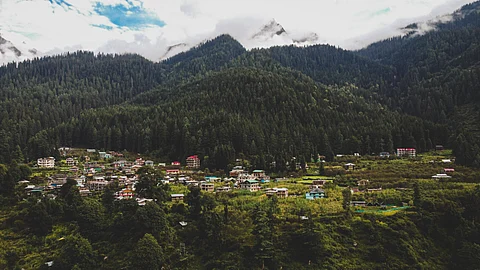
- Destinations
- Experiences
- Stay
- What's new
- Editor’s Picks
- Responsible Tourism
- CampaignsCampaigns
- Subscribe

Hidden in the Parvati Valley of Himachal Pradesh lies a small village known for its stunning landscapes, apple farms and starry nights—Pulga. The fact that getting to Pulga requires setting off on foot means that this charming place is miles away from the crowds and noise of city life. Those who are keen to live a slower pace of life, one that is more attuned to the ways of the living world and in conversation with other living creatures, will find the village to be a rejuvenating getaway. You won’t be fully cut off from the rest of the world, though; the region has excellent phone and internet connectivity.
Here’s what you should know about a visit to Pulga in the winter.
One of the most striking aspects of a visit to Pulga is the houses. Made from wood, these dwellings have detailed carvings and unique architecture, with amazing views of the lush forests and mountains. A walk through the narrow lanes of the village will make you feel as if you've stepped back in time. Staying in the wooden houses is a cosy experience, one made more so during the cold of winter.
If you want to warm up, though, consider heading into Pulga's unique cafés. These cosy places will make you feel right at home, so check out the Village and Wild Café, the #Capital Café, the Mountain Blend Café, and the Fairy Café, among many others, for some hot drinks and the company of locals and other visitors. Don't miss out on the famous “Nutella milk” experience. This addictive drink is made of milk, Nutella and ice and can be found in almost every café and accommodation in the village. Try it without the ice in winter, or request other variants of “Nutella milk,” such as Nutella coffee, Nutella shake and Nutella banana.
One of Pulga’s biggest draws are its extensive forest trails, which see many trekkers and nature lovers in the spring and summer. However, winter brings its own charms, with snow-laden trees and a hushed quiet that permeates the still air. The village has vast fairy forests, which, as legends would have it, are home to magical fairies. Whether true or not, these dense deodar woods will remind you of the old fairytales. The fairy forests are the perfect vantage point from where to catch the magnificent views of the snow-capped Himalayas. You can trek, ski, snowboard and sled in the forest, mountains and valleys of Pulga. If you can, join in the celebrations of Lohri, which are marked with music and food in January.
Pulga is an ideal starting point for trekkers, as the trekking trails of Kheerganga and Tosh begin here. The village offers moderate hiking trails, surrounded by mountains and lush forests. Explore the so-called “Hummus Trail,” which was started by Israelis during their holidays in India. The trail crisscrosses India and maps the most beloved villages for tourists from that country. In the Parvati Valley, the triplet villages of Pulga, Kalgha and Tulga form part of the trail. You can also check with the friendly locals about their favourite hikes, but make sure you pack all the winter trek essentials before starting.
From July to November, the residents of Pulga harvest apples from their orchards. With permission from the owners, you can visit the apple farms and pluck the tasty and fresh orbs from their trees. You can also buy the organic apples from the farmers at a reasonable price.
At night, Pulga offers one of the best stargazing experiences anywhere in India. Far from the lights and noise of the chaotic city, here you can witness the most breathtaking and awe-inspiring display of stars and constellations.
Did you know that most kids in Pulga know how to hula hoop? They twirl it with such ease and grace that you will be mesmerised by their skills. The kids learn how to use hula hoops from a young age, as it is a common and popular toy in the village.
Another unique fact about Pulga is that its groceries are transported through a ropeway system. Consisting of cables and pulleys, the ropeway connects Pulga with Barshaini, helping to transport groceries and other essentials to the village. The ropeway was built by the local authorities as a solution to the problems of accessibility and convenience. The ropeway is also used by some adventurous travellers who want to experience the thrill of flying over the valley.
Consider stays at the Hotel Marigold, Apple Cottage Homestay and Café, The Ice Blue bed and breakfast, the Secrets of Parvati hotel, Baba’s Homestay and Café, YOLO Backpackers, and Bella View Hostel, among many other accommodations.
Fly to Kullu–Manali Airport (KUU) or take the train to Joginder Nagar Railway Station (JGNX). From these places, take a bus or taxi to Barshaini, the last place accessible by road in the Parvati Valley. From Barshaini, trek the three kilometres to Pulga, which will take about an hour. The trek is easy and scenic as you cross wooden bridges, waterfalls and apple farms on the way. You can also hire a guide or a porter to help you with your luggage and show you the route.
